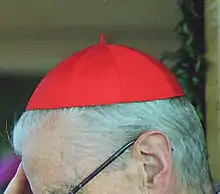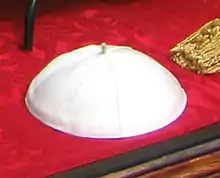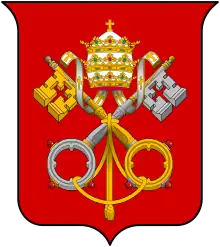Zucchetto
The zucchetto (/(t)suːˈkɛtoʊ, zuːˈ-/,[1] also UK: /tsʊˈ-/,[2] US: /zʊˈ-/,[3] Italian: [dzukˈketto]; meaning "small gourd", from zucca, "pumpkin")[lower-alpha 1][4] is a small, hemispherical, form-fitting ecclesiastical skullcap worn by clerics of various Catholic churches, the Syriac Orthodox Church, and by the higher clergy in Anglicanism. The plural is zucchettos[1][2][3]; it is also known by the names pilus, pilos, pileus, pileolus (pileolo), subbiretum, submitrale, soli deo (solideo), berrettino, calotte (calotta).[5]

History
The zucchetto originated as the Greek pilos and is related to the beret (which itself was originally a large zucchetto). It was adopted circa the Early Middle Ages, if not earlier, to keep clerics' heads warm. Its name derives from its resemblance to half a pumpkin. Its appearance is almost identical to the Jewish kippah (yarmulke), and this is often considered to have been deliberate (as a reminder of Jesus's Jewish heritage), though its religious significance is ultimately quite different regardless.[6]
Construction and design

In the Catholic tradition, the zucchetto is most commonly made of silk or polyester fabric. The design utilises eight triangular panels that are joined to form a hemispherical skullcap. Jutting from the centre of the zucchetto at the top is the "stem", known as stirpis or stirpes. It is made of a twisted loop of silk cord and is meant to make the handling of the zucchetto easier. The stirpes is the primary visual distinction between the zucchetto and the Jewish kippah.
The zucchetto has a lining of thin leather (chamois) as an insulator; this was also meant to help keep the shape of the zucchetto. Inside the trim there is a strip of velvet to ensure a secure and comfortable fit. Most modern zucchetto designs include a cloth lining, and the modern trend is toward a zucchetto of ordinary synthetic cloth lined with a simple natural cloth lining.[7]
The color of the zucchetto specifically denotes the wearer's rank and is in keeping with the five colors:
- the pope's and pope emeritus’ zucchetto is white;
- those worn by cardinals are scarlet;
- those of archbishops, bishops, territorial abbots and territorial prelates are amaranth;
- and priests and deacons wear a black zucchetto.
The use of the black zucchetto by priests and deacons is generally uncommon and widely considered an eccentricity. Some friar-preachers have adopted the practice of wearing a brown zucchetto to match their brown habit.[8] The pope customarily wears a white zucchetto to match his white cassock.[9]
The most common Anglican design can be similar to the Catholic zucchetto or, far more often, similar to the Jewish yarmulke.[10] A form of the zucchetto is worn by Anglican bishops and is used approximately like that of the Catholic Church. The Anglican "skullcap" differs from the zucchetto primarily in that it is made of six panels, bears a button at centre of the crown, and is of slightly larger dimensions. The other exception is Anglican churches usually (but not always) differ from the Catholic "church violet" for bishops, and instead use purple.
In the Syriac and Malankara Orthodox tradition, a seven-panel zucchetto called a phiro is worn by nearly all priests. It is always black and embroidered with black Orthodox crosses.[11]
Usage
All ordained members of the Latin Church of the Catholic Church are entitled to wear the black zucchetto (unless promoted to a higher rank) which is worn with either the cassock or liturgical vestments. The zucchetto is always worn beneath the mitre or the biretta. This is the reason for two of the alternate names for the zucchetto, subbirettum and submitrale.[12] The zucchetto is never worn with a suit. The amaranth and scarlet zucchetti are considered a symbolic honor granted to the prelate. In turn, the prelate is privileged to wear his zucchetto, not entitled.
The common tradition is for the cleric to obtain the zucchetto either from an ecclesiastical tailor or a retail church supply. There is also a tradition of friends buying the newly appointed bishop his first zucchetto.[13]
A lower-ranking prelate must always doff his skullcap to a higher-ranking prelate; all prelates must remove their zucchetti in the presence of the pope, unless the pope instructs them not to do so.[9]
The zucchetto is worn throughout most of the Mass, is removed at the commencement of the Preface, and replaced at the conclusion of Communion, when the Blessed Sacrament is put away. The zucchetto is also not worn at any occasion where the Blessed Sacrament is exposed. A short zucchetto stand known as a funghellino ("little mushroom", usually made of brass or wood) can be placed near the altar to provide a safe place for the zucchetto when it is not being worn.[12]
Prelates often give away their skullcaps to the faithful. The practice, which was started in the modern era by Pope Pius XII, involves giving the zucchetto to the faithful, as a keepsake, if presented with a new one as a gift. Popes John Paul II, Benedict XVI, and Francis have continued the custom.[14] The pope might choose not to give the visitor his own zucchetto, but rather place the gift zucchetto on his head for a moment as a blessing, then return it. Bishops, cardinals and archbishops such as Fulton J. Sheen frequently gave their old zucchetto in exchange for the newly offered one; Sheen also gave his zucchetto as a keepsake to laity who requested it.[14]
See also
Notes
- Compare zucchini, of related origin.
References
Footnotes
- "Zucchetto". Collins English Dictionary. HarperCollins. Retrieved 3 June 2019.
- "zucchetto" (US) and "zucchetto". Oxford Dictionaries UK Dictionary. Oxford University Press. Retrieved 3 June 2019.
- "zucchetto". Merriam-Webster Dictionary. Retrieved 3 June 2019.
- (in Italian) Dizionario Treccani
- Marshall 2009, pp. 11–13.
- Kilgour 1958; Marshall 2009, pp. 11–13.
- McCloud 1948, pp. 79–81.
- Kilgour 1958; McCloud 1948, pp. 79–80.
- McCloud 1948, pp. 79–80.
- anglicanhistory.org
- Kilgour 1958.
- Braun 1912; McCloud 1948, p. 79.
- Knox, Noelle (April 7, 2005). "Tailor pays tribute". USA Today. McLean, Virginia. Retrieved September 21, 2017.
- Duffy 2006.
Bibliography
- Braun, Joseph (1912). "Zucchetto". In Herbermann, Charles (ed.). Catholic Encyclopedia. 15. New York: Robert Appleton Company. pp. 765–766 – via Wikisource.
- Duffy, Eamon (2006). Saints and Sinners: A History of the Popes (3rd ed.). New Haven, Connecticut: Yale University Press. ISBN 978-0-300-11597-0.
- Kilgour, Ruth Edwards (1958). A Pageant of Hats Ancient and Modern. New York: R. M. McBride Company.
- Marshall, Taylor (2009). The Crucified Rabbi: Judaism and the Origins of Catholic Christianity. The Origins of Catholicism. 1. Dallas, Texas: Saint John Press. ISBN 978-0-578-03834-6.
- McCloud, Henry (1948). Clerical Dress and Insignia of the Roman Catholic Church. Wisconsin: Bruce Publishing Company.
Further reading
- Wray, Cecil Daniel (1856). A Short Inquiry Respecting the Vestments of the Priests of the Anglican Church. London: Joseph Masters. Retrieved December 26, 2011 – via Project Canterbury.
